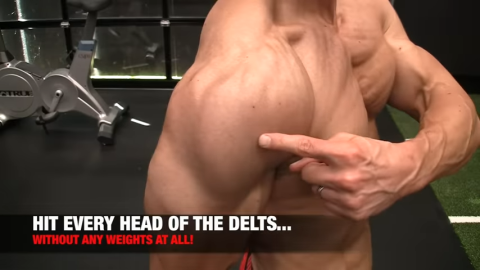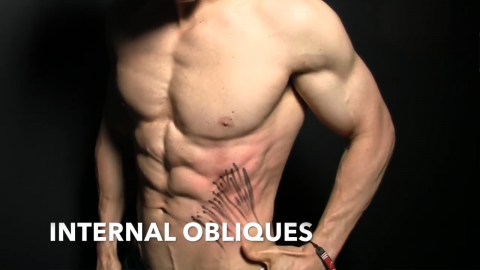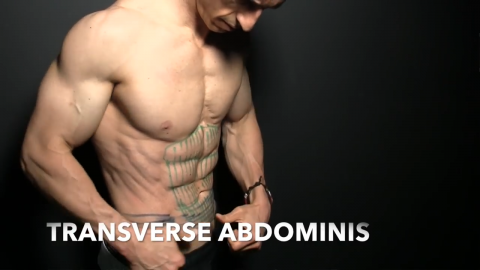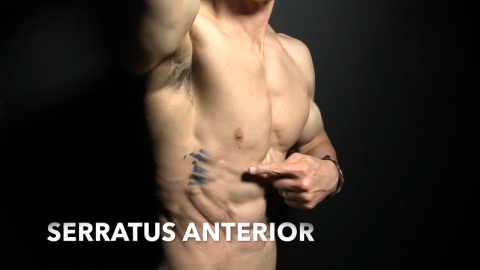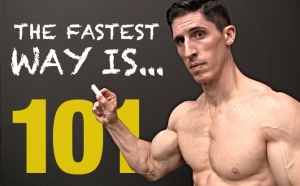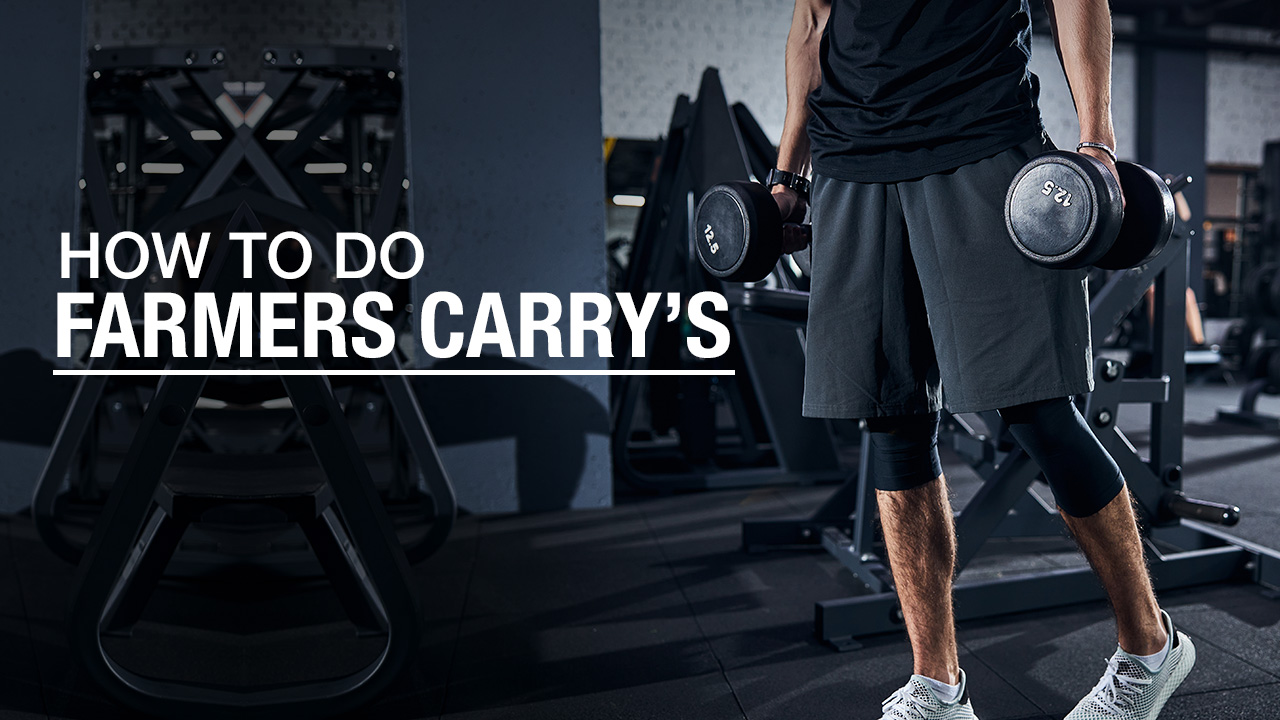
DON’T IGNORE THE FARMERS CARRY
Are you skipping the Farmers Carry because you think it’s just a “grip strength” exercise?
BIG MISTAKE.
You’re not just missing out on major gains here, guys! You’re also missing out on one of the most functional movements in fitness.
The Farmers Walk isn’t just about walking around with heavy weights.
It’s a full-body exercise that builds ironclad traps, bulletproof shoulders, a rock-solid core, and even helps burn fat.
If you’re not incorporating this into your routine, you’re doing your body a disservice.
Let’s break down why the Farmers Carry is one of the most underrated exercises for building raw strength and athleticism – and how you can start mastering it today.
FARMERS WALK: MUSCLES WORKED
The Farmers Walk is more than walking around with 100-pound dumbbells – it’s about mastering the mind-to-muscle connection during this most bang for your buck exercise.
Engaging the right critical muscles, maintaining posture, and focusing on each step are key to building grip strength, core stability, and overall functional strength.
Using 50-pound kettlebells, dumbbells, or portable farmer handles, this carry exercise targets shoulders, calves, and core, while improving posture, preventing injury, and boosting explosive strength.
The Farmers Carry challenges your conditioning practice, delivers essential benefits for strength sports and overall fitness, and provides a boost in functional grip strength.
Here are the major muscle groups that it targets:
UPPER TRAPS
The Farmers Carry directly challenges the upper traps.
This powerhouse exercise stabilizes the shoulders and maintains posture as you walk with heavier weights.
The muscle fibers of the upper traps run down and out from the base of your skull toward the tips of your shoulders, allowing for scapular elevation and upward rotation.
As you carry kettlebells, dumbbells, or weight plates over a distance, your traps and upper back muscles work hard to keep your shoulders from slumping forward.
This exercise challenges your postural strength, helping to improve scapular positioning, which is vital for preventing risk of injury and maintaining proper alignment under heavy loads.
The upper traps also contribute to neck stability, aiding in rotation, extension, and lateral flexion during the carry.
The Farmers Carry develops solid grip strength and functional strength while it enhances core stability and overall body strength.
This makes it a total body power exercise with carryover to strength sports and real-life movements.
FRONT DELTS (ANTERIOR DELTS)
The anterior deltoids, located at the front of your shoulders, play a key role in the Farmers Walk by supporting shoulder flexion as you stabilize the weight.
Their function extends beyond simply lifting your arm forward; they also assist with internal rotation and horizontal adduction, which are important for maintaining proper posture and control during the carry.
While the Farmers Walk is often seen as a grip and core strength exercise, it’s also an excellent non-traditional exercise for strengthening and stabilizing the anterior delts, especially under heavier loads or shorter distances.
Relying on traditional chest-day exercises alone won’t fully develop well-rounded shoulders.
To enhance shoulder strength and stability, you need a mix of compound movements, like the Farmers Carry, combined with isolation exercises.
The carry’s ability to engage the anterior delts while simultaneously boosting absolute strength, postural strength, and overall functional conditioning makes it an excellent exercise with carryover to strength sports and injury prevention.
SIDE DELTS (LATERAL DELTS)
The lateral deltoids, or side delts, are key to achieving that broad-shouldered look.
Their primary function is shoulder abduction, which involves lifting your arms out to the sides.
While this movement might seem minor, it’s essential for stabilizing your arms and maintaining proper posture during the carry.
The lateral delts also assist in more complex movements, like rotating your shoulder while your elbow is bent, which comes into play as you control an unstable load.
In the context of the Farmers Walk, the side delts help you maintain alignment, especially when dealing with uneven or asymmetrical challenges.
Look beyond carrying heavy dumbbells or kettlebells.
This movement challenges your shoulder and upper limb stability, core strength, and body strength as you walk with the weight to carry for time or distance.
Adding this movement to your routine will provide an improvement in grip strength, lumbar muscle strength and stability, and carryover to other strength sports.
FOREARMS
The forearms are key players in the Farmers Carry with notable benefits such as directly influencing your grip strength.
Extending from the elbow to the wrist, these muscles stabilize your grip during the entire time you carry weight, helping prevent loss of strength and ensuring proper posture.
Whether you’re performing carry variations or lifting heavier loads, strong forearms support wrist stability and enhance overall strength.
LATISSIMUS DORSI
The latissimus dorsi muscles, or lats, are large, fan-shaped muscles that span the middle and lower back.
During this strength and cardiovascular exercise, the lats stabilize the upper body muscles, maintaining an upright posture as you carry weight over a distance.
These muscles are essential for pulling movements, controlling arm stability, and preventing a hunched posture.
Strong lats contribute to a broader back, but they also enhance core strength, lumbar stabilization, and overall body mechanics during heavy carries.
The Farmers Walk offers more than just strength – it demands mental toughness, balance, and biomechanical efficiency during exercise circuits.
Whether carrying for time, using lighter weights, or performing variations with kettlebells, your lats are always at work, ensuring that your posture remains solid and preventing the risk of injury during extreme weights or longer carries.
RECTUS ABDOMINIS
The rectus abdominis, commonly known as the six-pack muscle, runs vertically from your ribcage to your pelvis and helps with the Farmers Carry.
This muscle provides essential core strength and stability, helping you maintain proper posture and resist poor alignment as you carry the typical weight over a distance.
These abdominal muscles ensure your trunk stays strong and steady throughout this multiplanar exercise, even as you face the challenge of heavier loads or variations like kettlebells.
This lumbar stabilization exercise improves metabolic conditioning as well as enhances your ability to handle increases in weight and variations of the carry training.
EXTERNAL OBLIQUES
The external oblique muscles, composed of diagonal fibers running from your ribcage to your pelvis, provide rotational stability and core strength.
These muscles frame your rectus abdominis and help maintain proper posture while carrying heavy weights.
In the Farmers Walk, engaging the external obliques is a must for keeping your core tight and preventing poor posture, especially when handling heavy dumbbells or kettlebells over distance.
This focus on stability not only reduces the risk of injury but also ensures you get the most out of each carry.
INTERNAL OBLIQUES
The internal obliques, which run diagonally from your ribcage to your hips, work opposite the external obliques and are vital for core stability during the Farmers Carry.
These muscles provide the deep core tension needed to keep your position strong as you carry weight, preventing your torso from collapsing under the load.
When performing the exercise, engaging the internal obliques ensures that your core remains tight and stable, helping you maintain balance and control throughout the exercise.
This is especially important as strong internal obliques prevent loss of muscle strength and enhance overall posture.
Whether you’re using body weight, bodyweight variations, or heavy loads, focusing on your internal obliques boosts the effectiveness of the exercise.
TRANSVERSE ABDOMINIS
The transverse abdominis, often referred to as your body’s natural weight belt, wraps around your waist as one of the deepest core stabilizers.
The Farmers Carry trains muscles that maintain core tension and stability, ensuring your posture stays strong and your trunk remains solid under load.
Proper engagement can be a challenge for people, but it boosts your performance and reduces the risk of injury, making it a key component in cardiovascular conditioning exercises, strength workouts, and biomechanical efficiency.
SERRATUS
The serratus anterior, often overlooked in core training, plays a vital role in the Farmers Walk by stabilizing the shoulder blades and keeping them connected to the rib cage.
By engaging the serratus anterior, you enhance shoulder joint stability and core strength, which supports the overall power of trunk.
Whether you’re navigating variations in load or distance, the serratus anterior helps keep your form tight and controlled, making it an essential muscle in strength training and functional exercises.
HOW TO DO THE FARMERS CARRY
The Farmers Carry is a foundational strength exercise with roots that go back to the dawn of time in functional fitness.
Simple in setup yet versatile in execution, it’s a powerful way to build full-body strength, stability, and conditioning.
Whether you’re using kettlebells, dumbbells, or other implements in strength training, this exercise variety challenges your grip, core, glutes, and even your calf muscles assist in the movement.
Conditioning professionals often include the Farmers Walk as a key movement in their routines.
This is because of its carryover to functional strength and its potential to be adapted with other exercises like Power Cleans, Deadlift variations, and hip extension variations.
Let’s break down how to perform this exercise correctly for maximum results.
FARMERS CARRY

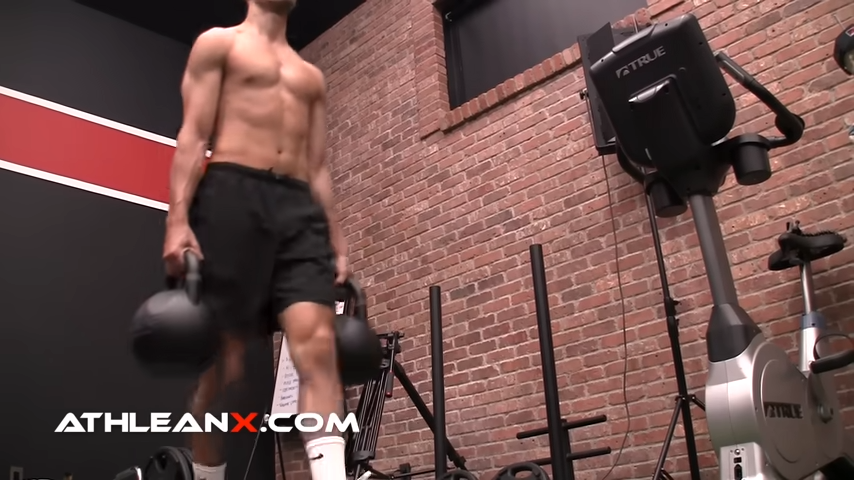
HOW TO DO THE FARMERS CARRY:
- Grab a pair of heavy dumbbells or kettlebells that challenge you. Take extra time to set up if you need it. The market for kettlebells is huge, so find ones that suit your strength level.
- Stand tall with your feet shoulder-width apart, weights at your sides. Keep your chest up and engage your core – this isn’t just a firm grip or glute exercise; it’s a full-body workout.
- With your shoulder positioning back and core tight, walk in a straight line. Focus on stability and avoid swaying. Your calf muscles assist in maintaining balance, while your glutes and core keep everything aligned.
- Walk for a set distance or period of time – whatever works best for your conditioning level. Conditioning coaches often recommend starting with shorter distances and gradually increasing the challenge.
WHAT MAKES IT EFFECTIVE: The real potential in exercises like this lies in maintaining posture and control the entire time. Don’t rush it – focus on quality reps instead of speed.
FARMERS CARRY WITH VERTICAL DISPLACEMENT


HOW TO DO THE FARMERS CARRY WITH VERTICAL DISPLACEMENT:
- Choose a weight – consider lighter weights for this exercise.
- Start by holding one weight at your side with one arm fully extended, while pressing the other weight overhead with the opposite arm. Your feet should be shoulder-width apart, core braced, and glutes engaged.
- To maintain balance, you’ll need to brace your core tightly. The offset load creates instability, so your core, glutes, and even your calf muscles will need to work harder to keep you steady.
- Begin walking in a straight line with controlled steps and knees. Keep your shoulders stacked and avoid leaning or tilting to one side. Your overhead arm should remain fully extended with your elbow locked out, while the arm at your side should stay straight and engaged.
- The goal is to maintain proper posture and resist the urge to sway or tilt. Concentrate on keeping your torso upright and your overhead arm aligned directly above your shoulder. The vertical displacement adds a significant challenge to your core, shoulders, and hips, enhancing stability and strength.
- After completing the distance or time on one side, switch the weights and repeat the carry with the opposite arm.
WHAT MAKES IT EFFECTIVE: The Farmers Carry with vertical displacement is an advanced variation that challenges your stability, coordination, and core strength by placing one arm overhead while the other remains by your side. This asymmetrical load forces your entire body to work harder to maintain balance and proper posture throughout the movement.
FARMERS WALK: COMMON MISTAKES
The Farmers Walk is simple in terms of setup time, and it has incredible potential when done correctly.
However, common mistakes can limit the benefits and even lead to injury.
From poor posture to rushing the exercise, these errors can reduce the effects of gluteus muscle, core, and even the calf muscles that assist in maintaining balance.
Let’s break down the key pitfalls so you can maximize the effectiveness of this exercise.
SLOUCHING SHOULDERS
One of the biggest mistakes people make is letting their shoulders round forward.
When this happens, you’re losing out on activating the traps and core, which are critical to the effectiveness of the exercise.
To avoid this, think about pulling your shoulder blades back and down as if you’re trying to “tuck them into your back pockets.”
Keep your chest up and eyes forward to maintain that strong, proud posture.
WOBBLING SIDE TO SIDE
If you’re swaying or wobbling from side to side, it’s a clear sign that your core isn’t fully engaged.
This not only reduces the effectiveness of the carry but also increases your risk of injury.
Tighten your core like you’re bracing for a punch and make sure your glutes are activated to keep your body stable.
Controlled steps are key – avoid rushing through the walk just to get it over with.
GOING TOO LIGHT
Let’s be real – if you’re picking up weights that you could carry all day without breaking a sweat, you’re not challenging your muscles enough.
The potential in this exercise comes from using heavy weights that push your limits while still allowing you to maintain good form.
Don’t be afraid to test your strength – this is where real progress happens.
Gradually increase the load over time to keep your muscles adapting and growing.
SHORT STRIDES
Taking tiny, hesitant steps is a common mistake that limits the involvement of your calves, glutes, and even your core.
To fully engage these muscles, focus on taking deliberate, controlled steps.
Your feet should be shoulder-width apart, and each stride should be confident and strong.
Remember, the calf muscles assist in keeping your balance and power with each step, so make sure you’re moving with purpose.
RUSHING THE WALK
The Farmers Walk isn’t about getting from point A to point B as quickly as possible.
The level of setup time is low, but the payoff comes from doing the exercise with precision.
Speeding through the walk leads to sloppy form, reduced stability, and less muscle activation.
Slow it down and focus on the quality of each step – it’s about building raw strength, not just checking off reps.
Guys, the Farmers Carry is one of the most effective, no-nonsense exercises you can add to your routine for building full-body strength, stability, and burning fat.
Keep your form tight, challenge yourself with heavy weights, and walk with purpose to maximize the benefits.
Don’t skip this – the gains you’ll see from consistent Farmers Walks are too good to ignore.
If you’re looking for a training program that covers every muscle in the body, we’ve got you covered. Check out our ATHLEAN-X programs to see which is the best fit for your goals and fitness level.

- The Farmers Carry or Farmers Walk is a total body strength challenge that engages nearly every key muscle group, from your traps and shoulder mobility to your core, forearms, glutes, and legs.
- Here’s how to do the Farmers Carry:
- Pick up a set of dumbbells or kettlebells that feel heavy enough to push your limits.
- Take a moment to get your stance and grip right – it’s worth the effort.
- Stand upright, feet about shoulder-width apart, with the weights held firmly at your sides. Lift your chest and brace your core.
- As you start walking, keep your shoulders pulled back and your core engaged to prevent any swaying.
- Walk for either a specific distance or time, depending on your fitness level.
- If you want to add an extra challenge, try performing the entire movement with one dumbbell or kettlebell overhead. Switch arms once you walk the specific time or distance.
FARMERS CARRY FAQ
The Farmers Carry is a full-body strength builder. When you pick up heavy weights and walk with them, here’s what’s happening:
Traps and Shoulders: Your traps, especially the upper traps, are working overtime to stabilize your shoulders and keep them from collapsing under the load. Your delts are in on the action too, helping maintain good posture.
Core: Your abs, obliques, and deep core muscles like the transverse abdominis are firing non-stop to keep your torso upright and balanced. Without a strong core, you’ll end up tilting or swaying – and that’s not what you want.
Forearms: Grip strength is huge here. Your forearms are working the entire time to hang onto the weights. Weak grip? You’ll feel it.
Lats: Often overlooked, but your lats are stabilizing your upper body, keeping everything locked in tight.
Legs and Glutes: Every step engages your glutes, quads, hamstring muscle, and even your calf muscles. It’s not just about carrying the weight – it’s about controlling each step.
The Farmers Walk is a full-body movement that works your traps, shoulders, core, grip, and legs all at once. If you’re not doing this, you’re missing out on one of the best functional exercises out there.
When it comes to the Farmers Carry, the weight should be heavy enough to challenge you but still allow for perfect form.
Ideally, you should aim for carrying 75-100% of your bodyweight in each hand if you’re focused on building strength.
However, the key is maintaining proper posture throughout – shoulders back, core tight, and steps controlled.
If you’re leaning, wobbling, or struggling to finish, you’re likely going too heavy and should scale it back.
Your training goal also matters: for conditioning and muscle endurance, opt for lighter weights with longer carries; for pure strength, go heavier with shorter distances.
The weight should be challenging enough that the last few steps feel like a grind, but your form stays rock solid.
Nail that balance, and you’ll unlock serious improvements in strength, stability, and conditioning.
The Farmers Carry is hands down one of the best exercises you can add to your routine.
It’s a full-body strength builder that targets almost every major muscle, including your traps, rotator cuff muscles, core, forearms, glutes, and legs.
The move is simple but has massive carryover to real-life strength and athletic performance.
It’s also great for improving posture, especially if you’re dealing with rounded shoulders from sitting at a desk all day.
By engaging your traps, lats, and core, the farmer’s carry reinforces good posture while keeping you upright and balanced.
On top of that, it’s a go-to exercise for building grip strength, which is necessary for lifts like deadlifts and for preventing injuries by teaching your body to stabilize under load.
The best part?
It’s low risk and high reward – as long as you maintain proper form, the risk of injury is minimal.
Absolutely, Farmer Carries are great for your abs – but not in the way you might think.
Unlike traditional ab exercises like crunches or sit-ups, the Farmers Carry challenges your core in a more functional and effective way.
As you walk with heavy weights, your abs, especially the deeper core muscles like the transverse abdominis, are working overtime to keep your torso stable and prevent you from leaning or twisting.
This constant tension is what builds true core strength that translates to better posture, improved stability, and more power in your lifts.
Plus, because the Farmers Walk is a full-body movement, you’re getting core activation while working your shoulders, traps, and legs at the same time.
So yes, if you want a strong, functional core that can handle real-world challenges, farmer carries should be a staple in your routine.
Yes, Farmers Carries can absolutely help you burn fat – and here’s why.
This exercise is one of the full body loaded movements that cranks up your heart rate and engages multiple muscle groups at once, which means you’re burning more calories than you would with isolation exercises.
The combination of heavy loads and continuous movement puts your body into a metabolic overdrive, making it an effective conditioning tool for fat loss.
Plus, the farmer’s carry helps build muscle, and more muscle equals a higher resting metabolic rate, meaning you’ll burn more calories even after your workout is done.
If fat loss is your goal, adding the Farmers Walk to your routine is a smart way to torch calories while building strength at the same time.

Jeff Cavaliere M.S.P.T, CSCS
Jeff Cavaliere is a Physical Therapist, Strength Coach and creator of the ATHLEAN-X Training Programs and ATHLEAN-Rx Supplements. He has a Masters in Physical Therapy (MSPT) and has worked as Head Physical Therapist for the New York Mets, as well as training many elite professional athletes in Major League Baseball, NFL, MMA and professional wrestling. His programs produce “next level” achievements in muscle size, strength and performance for professional athletes and anyone looking to build a muscular athletic physique.


















